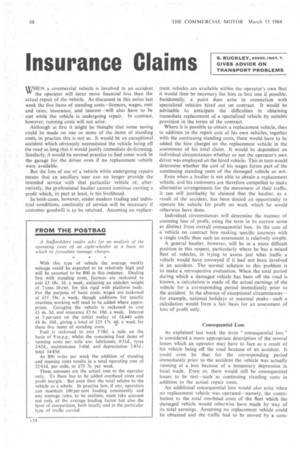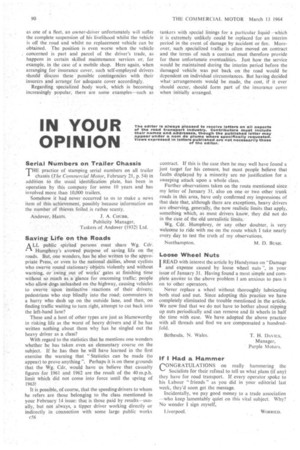Insurance Claims
Page 90

Page 91

Page 92

If you've noticed an error in this article please click here to report it so we can fix it.
WHEN a commercial vehicle is involved in an accident vv the operator will incur more financial loss than the actual repair of the vehicle. As discussed in this series last week the five items of standing costs—licences, wages, rent
and rates, insurance, and interest will also have to be net while the vehicle is undergoing repair. In contrast, however, running costs will not arise.
Although at first it might be thought that some saving could be made on one or more of the items of standing costs, in practice this is not so. It would be an exceptional accident which obviously necessitated the vehicle being off the road so long that it would justify immediate de-licensing. Similarly, it would be normal practice to-find some work in the garage for the driver even if no replacement vehicle were available. • But the loss of use of a vehicle while undergoing repairs means that an ancillary user can no longer provide the intended service with that particular vehicle or, alternatively, the professional haulier cannot continue earning a profit which, in part at least, is his livelihood.
In both cases, however, under modern trading and industrial-conditions,continuity of service will be necessary if customer goodwill is to be retained. Assuming no replace merit vehicles are available within the operator's own fleet it would then be necessary for him to hire one if possible. Incidentally, a point does arise in connection with specialized vehicles hired out on contract. It would be advisable to anticipate the difficulties in obtaining immediate replacement of a specialized vehicle by suitable provision in the terms of the contract.
Where it is possible to obtain a replacement vehicle, then in addition to the repair-cost of his own vehicles, together with the continuing standing costs, there would have to be added the hire charges on the replacement vehicle in the assessmek of his total claim. It would be dependent on individual circumstances whether or not -the operator's own driver was employed on the hired vehicle. This in turn would determine whether the cost of his wages forms part of the continuing standing costs of the damaged vehicle or not.
Even when a haulier is not able to obtain a replacement vehicle, and his customers are therefore compelled to make alternative arrangements for the movement of their traffic, it can still justifiably be claimed that the haulier, as a result of the accident, has been denied an opportunitY to operate his vehicle for profit on work which he would otherwise have done.
Individual circumstances will determine the manner of assessing loss of profit, using the term in its narrow sense as distinct from overall consequential loss. In the case of a vehicle on contract hire making specific journeys with a single traffic then such an assessment is relatively simple.
A general haulier, however, will be in a more difficult position in this respect, particularly where he has a mixed fleet of vehicles, in trying to assess just what traffic a vehicle would have conveyed if it had not been involved in an accident. The normal solution to this problem is to make a retrospective evaluation. When the total period during which a damaged vehicle has been off the road is known, a calculation is made of the actual earnings of the vehicle for a corresponding period immediately prior to the accident. In the absence of exceptional circumstances— for, example, national holidays or seasonal peaks—such a calculation would form a fair basis for an assessment of loss of profit only.
Consequential Loss
As explained last week the term "consequential loss " is considered a more appropriate description of the several losses which an operator may have to face as a result of his vehicle being off the road because of an accident. It could even be that for the corresponding period immediately prior to the accident the vehicle was actually running at a loss because of a temporary. depression in local trade. Even so, there would still be consequential losses to be met—such as continuing standing costs in addition to the actual repair costs.
An additional consequential loss would also arise when no replacement vehicle was operated—namely, the contribution to the total overhead costs of the fleet which the damaged vehicle would otherwise have made by way of its total earnings. Assuming no replacement vehicle could be obtained and the traffic had to be moved by a corn
petitor it would seldom, if ever, be possible for the haulier to temporarily reduce his overhead costs whilst the damaged vehicle is off the road. Therefore, if no claim was in fact made for this proportion of overhead costs, then the other vehicles in the fleet would have to share a higher proportion of overheads and so reduce their own profitability.
A difficulty arises here in the proportioning of overhead costs regarding whether, in fact, a vehicle has been involved in an accident. Assuming, as is most probable, that there are differing types of vehicles in the fleet, then a straight division of the total overhead costs by the number of vehicles in the fleet would not result in a fair proportion. Nor does a simple division on the basis of pay-load capacity prove entirely satisfactory. Particularly where both smalls traffic and general haulage are dealt with by a mixed fleet, a 3-tonner engaged on collection and delivery work might well involve as much, if not more administrative time and resources as a maximum load multi-wheeler operating a trunk service.
Admittedly any decision as to the apportionment of overhead costs must be to some extent arbitrary; but on balance, a percentage increase on the total operating costs, as used when compiling "The Commercial Motor" Tables of Operating Costs, gives as fair a basis as possible. Relating this percentage amount for individual vehicles to the actual gross total, overhead costs will give an actual amount for each vehicle, which can then be used for inclusion in an insurance claim.
Other Factors Other factors to be taken into consideration when making a claim are possible hire-purchase payments or contracthire charges. Where an accident is so severe that a vehicle is a complete write off and the operator is fortunate to have provided comprehensive insurance covering such an exceptional eventuality, then he can recover the agreed value of the vehicle from his insurers and so be in a position to meet payments or charges due from him.
In a great majority of cases, however, the damage will not be so severe and will involve the vehicle being off the road for a period only. In that event, with the hirepurchase payment of contract-hire charges still being presented for payment, it is important that the operator should have arranged for insurance cover to meet such costs whilst the revenue-earning capacity of the damaged vehicle has temporarily ceased.
It is particularly important for the operator to be aware of his position concerning consequential loss in the event of damage or destruction of a vehicle by fire. According to the terms of the individual policy it could be of crucial importance whether such a fire occurred on his own premises, at his customer's premises, or other points of collection or delivery, such as in a repair garage, on the road or public parking place.
In the first instance, when the incident occurred on his own premises, the operator would normally claim on the basis of his own fire policy. But unless appropriate precautions have been taken to provide insurance cover should fire occur elsewhere, an operator could sustain substantial loss. Thus he may have to hire a replacement vehicle to complete work he has legally contracted to undertake just as he would have to do if the vehicle had been damaged in an accident. It is therefore imperative that he should be in no doubt as to just what fire cover the insurance policy does provide. Otherwise, in the event of such a fire, he might find himself in the difficult position of having to acquire a replacement vehicle at his own expense to fulfil existing contracts and thereby retain a customer's
Further aspects of damage to a vehicle by fire—as distinct from that incurred in an accident—need consideration. In the rather unlikely event of a vehicle being completely burnt out it might be assumed that at least one problem was solved in that no complicated assessment of damage was necessary as a complete replacement is the obvious solution. But even in that event it should not be overlooked that immediate replacement of a particular model may not be possible. The manufacturer or local distributor may already have an appreciable waiting list. Such a position would, of course, be aggravated if the vehicle concerned was fitted with a special body. Again, prior provision for such eventuality and the cost of hiring a replacement vehicle, if necessary, in the interim period
should be made.
In contrast with the replacement of a damaged vehicle
as one of a fleet, an owner-driver unfortunately will suffer the complete suspension of his livelihood whilst the vehicle is off the road and whilst no replacement vehicle can be obtained. The position is even worse when the vehicle concerned is part and parcel of the driver's trade, as happens in certain skilled maintenance services or, for example, in the case of a mobile shop. Here again, when arranging for insurance cover, such self-employed drivers should discuss these possible contingencies with their insurers and arrangefor adequate cover accordingly.
Regarding specialized body work, which is becoming increasingly pOpular, there are some examples—such as tankers with special linings for a particular liquid--which it is extremely unlikely could be replaced for an interim period in the event of damage by accident or fire. Moreover, such specialized traffic is often moved on contract and the terms of such a contract must therefore provide for these unfortunate eventualities. Just how the service would be maintained during the interim period before the damaged vehicle, was put back on the road would be dependent on individual circumstances, But having decided what '.arrangements would be made, the cost, if it ever ,should occur, should form part of the insurance cover when initially arranged.








































































































































